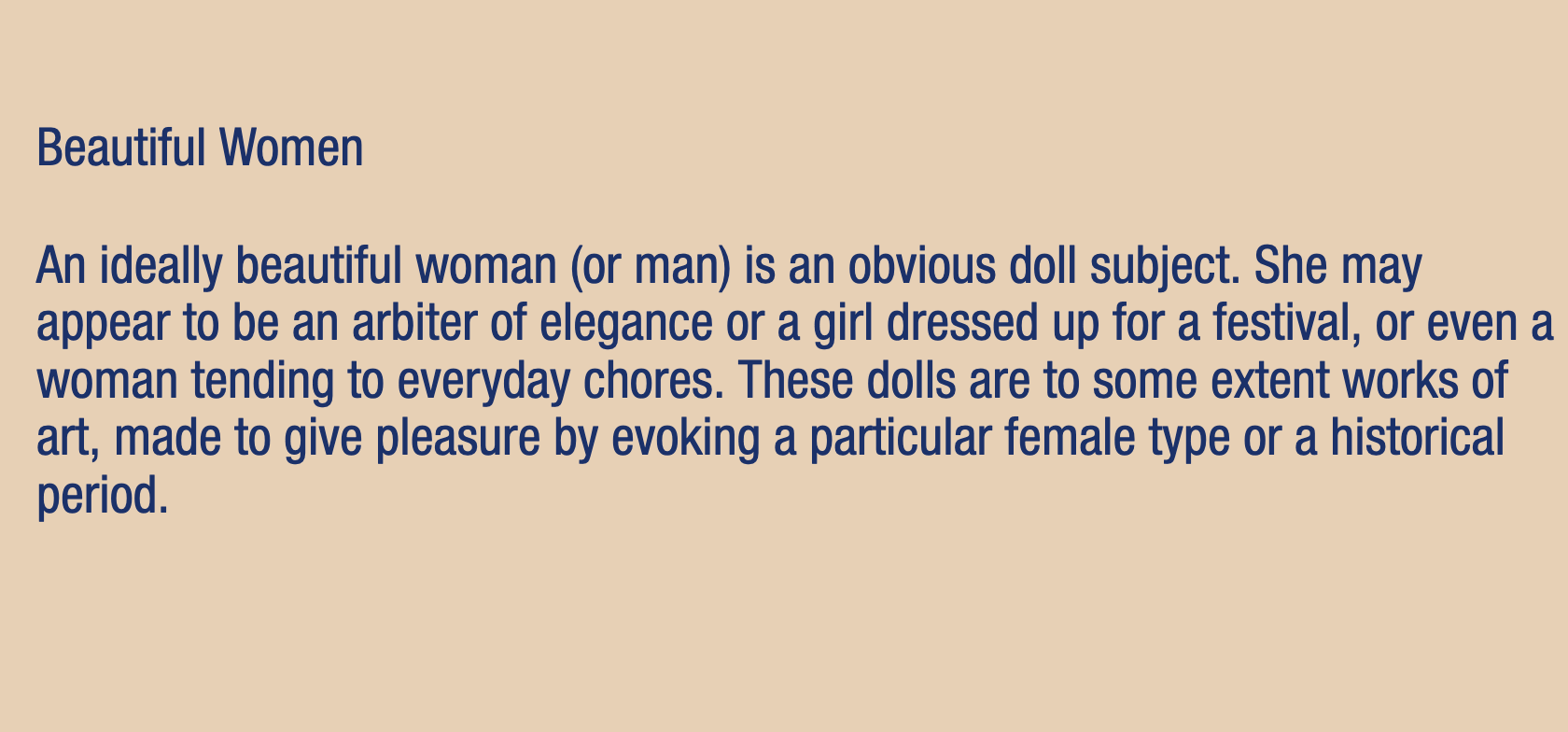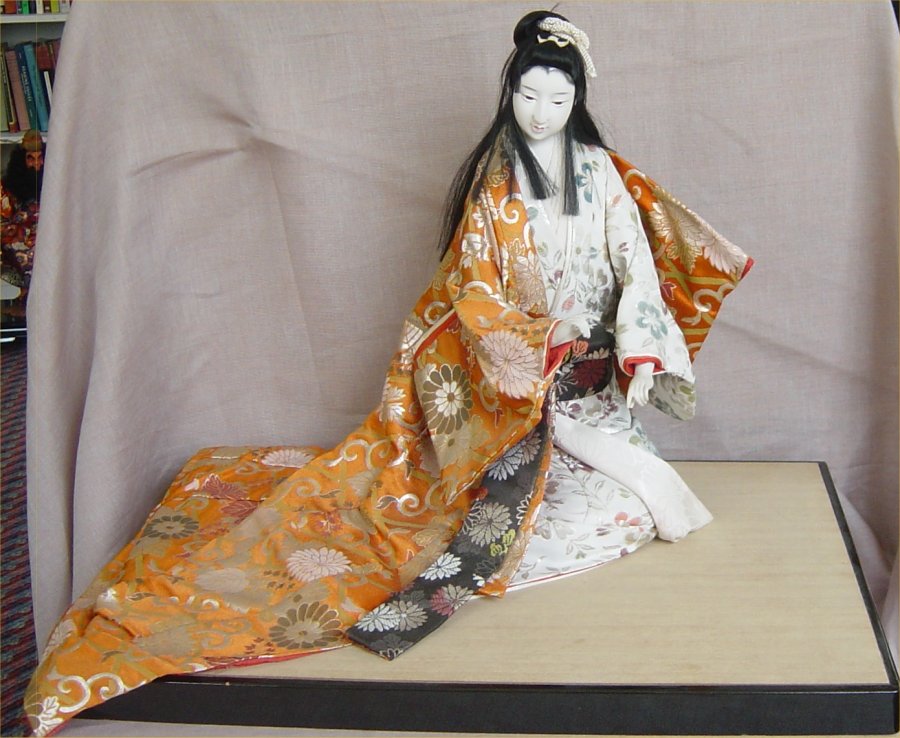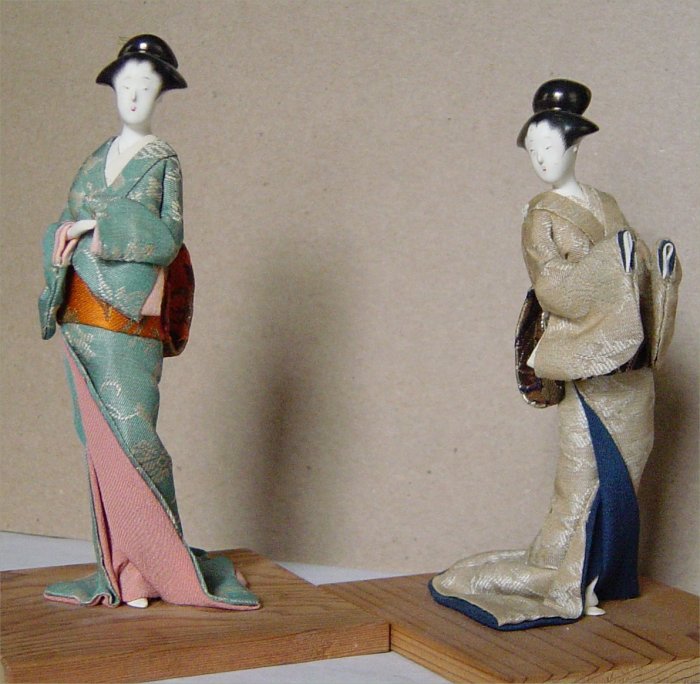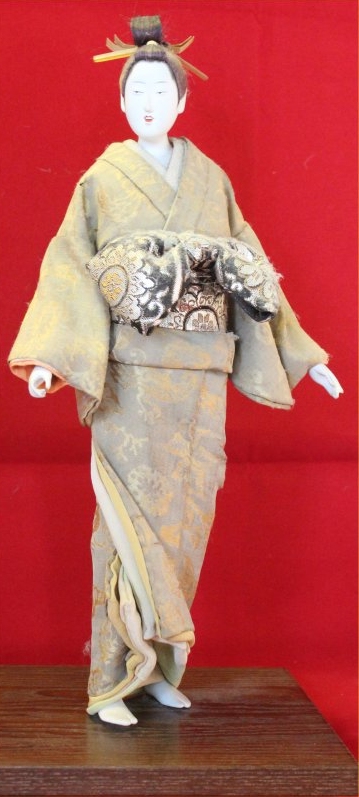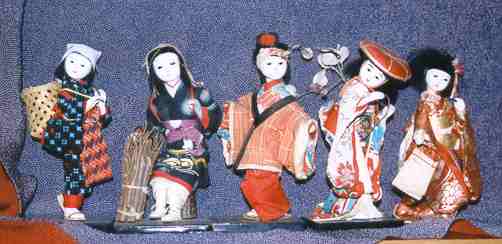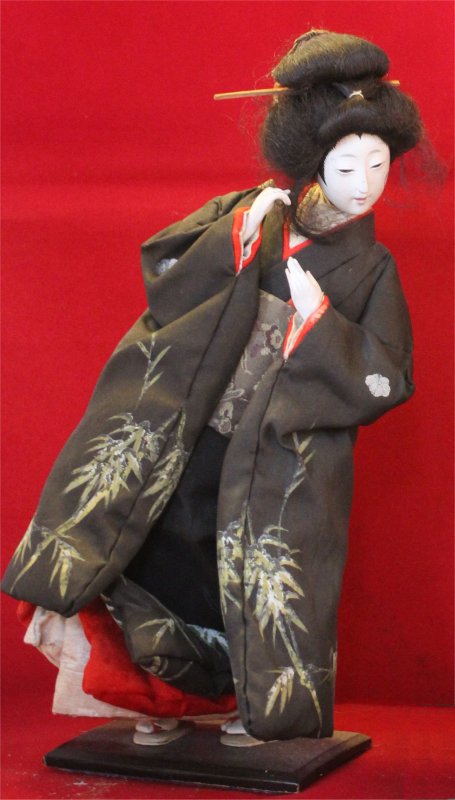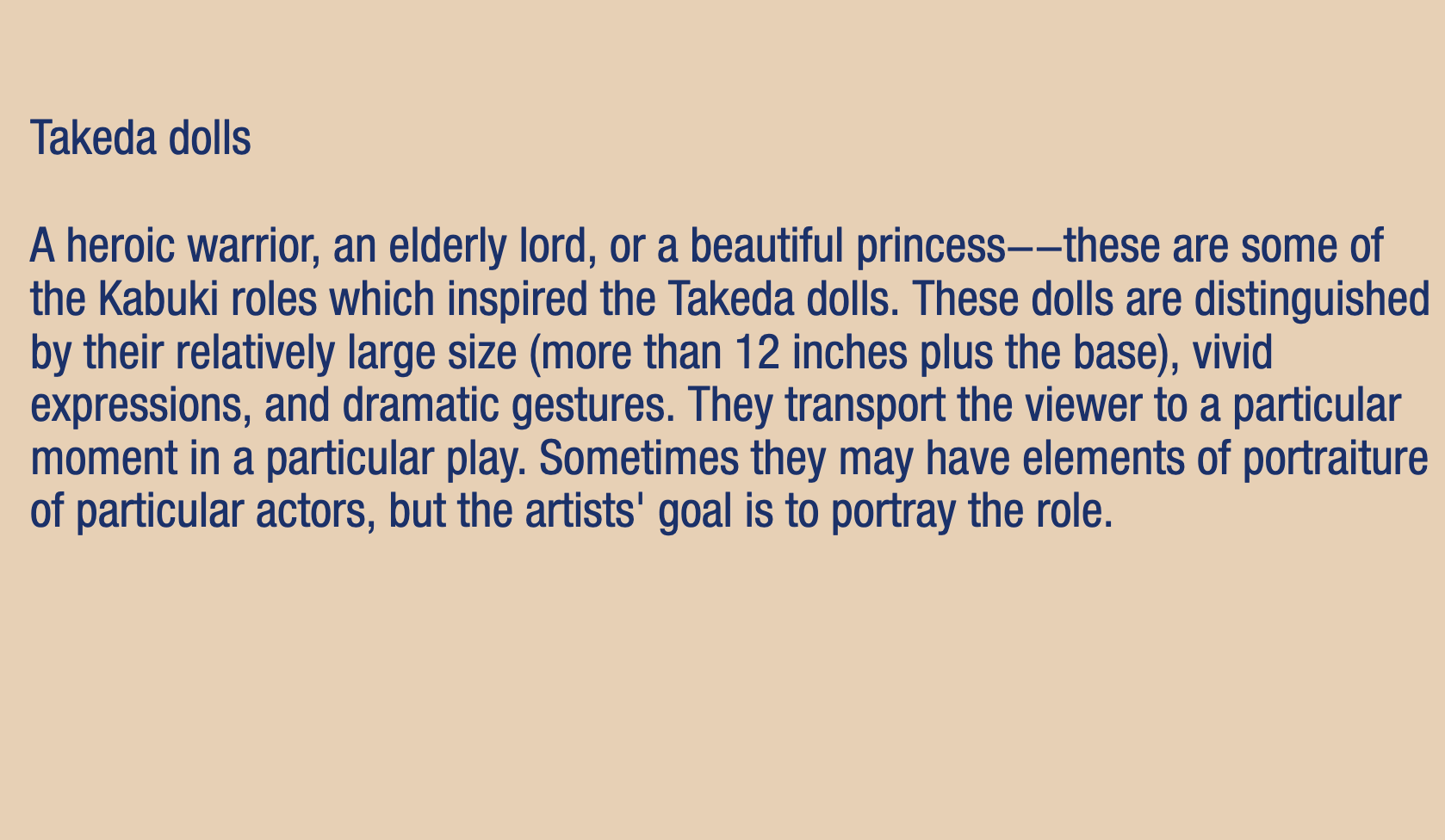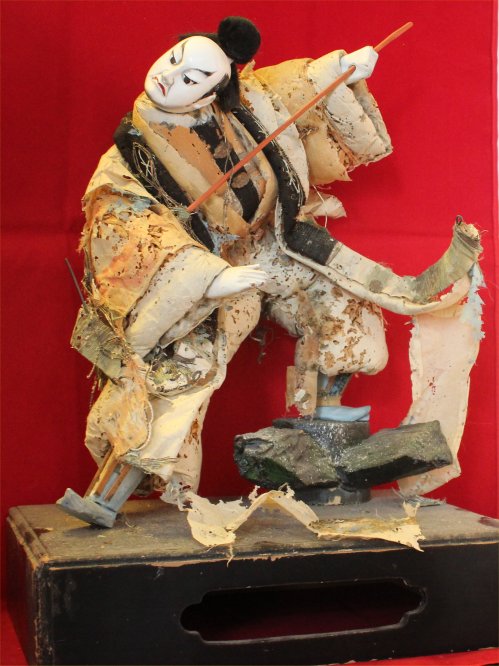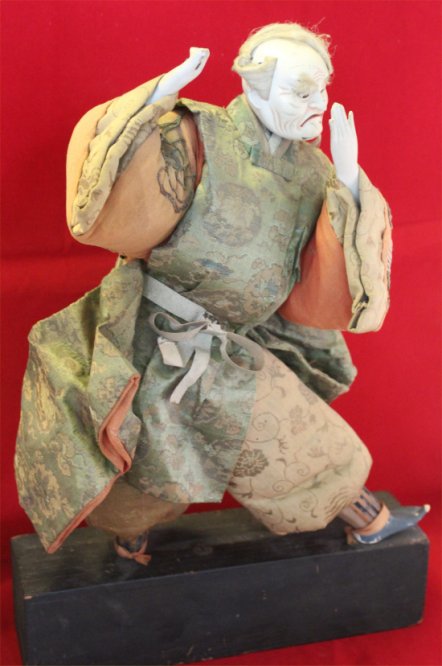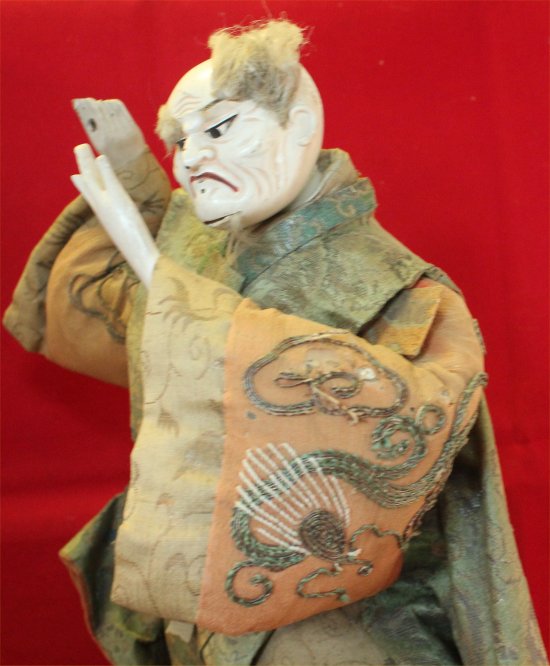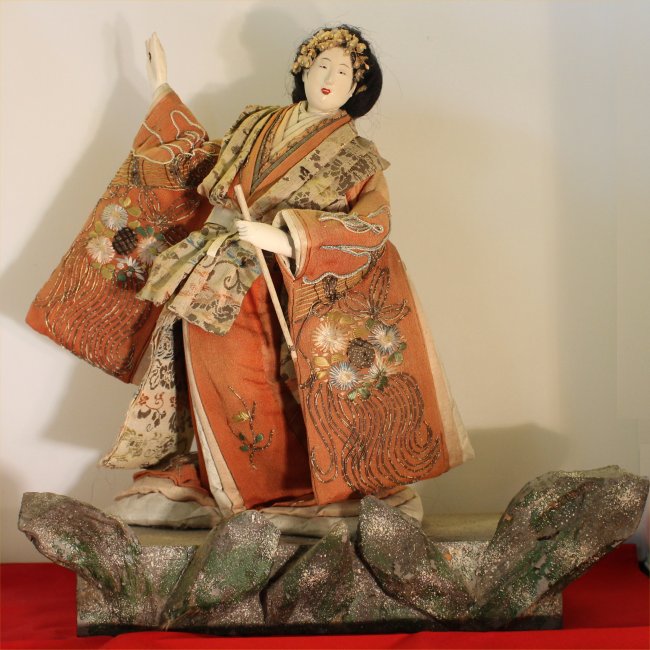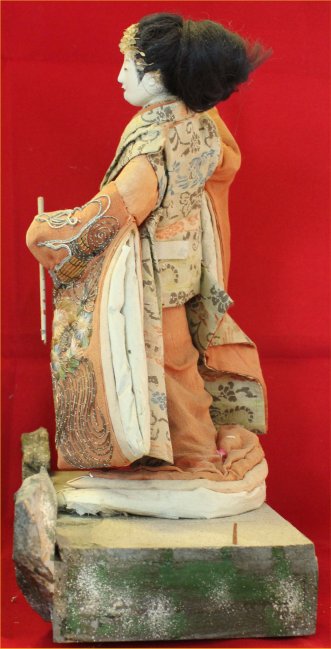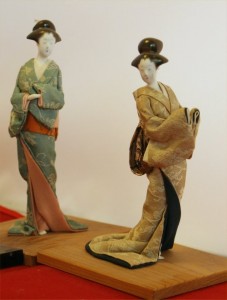
Ukiyo-e, “floating world pictures”
The 18th and 19th century produced in Japan an art form, Ukiyo-e, representing the “floating world” –an ephemeral life of pleasure and emotion, repugnant to Buddhist philosophy, but dear to the hearts of young men and essential to the economy and society of feudal Japan. This was the world of the Kabuki theater, with its favorite actors and their fans, and of the geisha (“talented persons” trained in music and dance) and the oiran (the most admired of the whores in the brothel zones or “pleasure quarters” of the big cities), who presided over salons for elegant social intercourse as well as sexual intercourse.
Play dolls and baby dolls were certainly loved by the geishas and brothel-dwellers themselves, and were as fashionable as all their other pastimes. So there was interaction in the development of many kinds of dolls as children’s toys were modified to suit courtesans and vice-versa. The jointed ichimatsu play doll was originally the effigy of a Kabuki actor (he was called Ichimatsu because it means “checked,” referring to a costume he wore in an important role)–a delightful gift for a young dancer or favored mistress.
As the floating world floated away in the 20th century, doll art commemorated the beauties and beloved dramatis personae of the Ukiyo. While earlier dolls had often represented the male roles in Kabuki, now the onnagata, or actor portraying a woman, was more likely to be represented. The onnagata usually perform dance solos which are the emotional core of the play, and these are the moments memorialized in the dolls.
Names for this type of doll include:
- Isho-bina or isho-ningyo: costume doll (a very broad designation that includes genre dolls of any kind)
- Ukiyo-ningyo: floating world doll
- Oyama ningyo: doll representing a female Kabuki role
- Kyoto ningyo: Kyoto doll (even though many types of dolls were made in Kyoto; see Gribbins, Japanese Antique Dolls)
- Sakura ningyo: cherry blossom doll (for the silk-faced dolls)
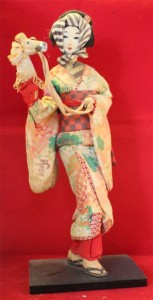
“Geisha dolls”
These days one often sees in antique malls tall, willowy Japanese ladies in elaborate silk kimonos and coiffures; the skin is usually of painted silk knit and the hands are wired to grasp a helmet, a drum, a branch of wisteria, a puppet, or a set of big red hats. Often they are in glass cases.
These dolls usually represent a particular Kabuki figure: the “Wisteria maiden” (Fujimusume) or the maiden who transforms into a lion, for example. They may also evoke important moments in the lives of ordinary women, showing for example a bride with her white hat. Sometimes they really are “geisha dolls,” representing the social categories of women devoted to entertainment in a man’s world: the geisha, maiko, or oiran.
The silk-mask-faced dolls were first designed by Kamimura Tsuyuko, a woman who had traveled in Europe and got the idea from French dolls; before the War, they were called Furansu (French) ningyo, but during the war were renamed Sakura ningyo, “Cherry-Blossom Doll”. They were a popular home craft, made from kits, and were also marketed by doll companies (Nishi, Kyugetsu). Most of the dolls of this type found in the U.S. now were produced after World War II, and found a ready market with military personnel who brought them home. Others were made to order as corporate gifts (notably those given by the Yamaha musical instrument company to American dealers).
Note that in the 1950s and 60s dolls were made using similar techniques but dressed in Western apparel, or with big anime-style eyes suggesting Western influence. These might also have been called Furansu or Sakura dolls.
These subjects were popular with many types of dollmakers, so that examples abound with gofun or gypsum faces and brocade clothing, or done entirely in pottery except for the odd hairpin or other accessory. Most recently China has mass-produced “geisha” dolls with plastic faces and hands.
Here is a page to help identify what a “geisha doll” represents.
Fashion dolls
Fashion dolls have been produced since at least the 18th century in Japan; they represent the activities of daily life, in the palaces of the mighty, the pleasure quarters (regulated brothel areas outside the major cities, such as Edo’s Yoshiwara district), or the streets. Such dolls may be called isho ningyo (or isho-bina), “costume dolls.”
Some types of these dolls are fixed in a pose on a platform. The pose and accessories may may suggest a geisha or samurai, a court lady, or a particular Kabuki role. Such dolls range from small, cheap ones to large, elaborate and expensive pieces of doll artistry, to home-craft “Sakura” dolls made from kits. While dolls of this type are usually made of various media, including beautiful fabrics, the Hakata dollmakers created pottery versions of these subjects, too.
Fashion dolls representing young women might also be constructed in “mitsuore” (triple-jointed) style, so that the doll could be dressed and undressed, and posed in the conventional sitting position. I have also seen pictures of such a doll with male genitals, indicating that it represents an onnagata or transvestite. Among the dolls of this type were some that had wigs–either a wig shop of which the doll was proprietor, or wigs for a doll, male or female, meant to represent an actor changing characters. A common souvenir set in the 1960s was a small doll (usually with a fixed body and clothing glued on) with a set of 6 wigs and explanations of the different hairstyles appropriate to a young girl and woman at different stages of her life; these were sold both in Japan and in the U.S.
Actors and their roles
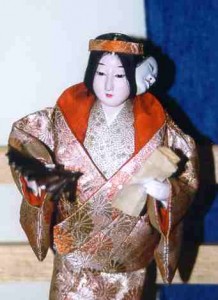
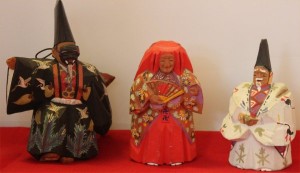
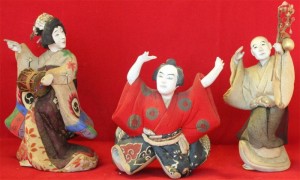
- Nara wood carvings, an old type of doll, frequently represent the characters of the sacred, masked Noh drama. This is not a theater of the “floating world” but a spiritual theater appealing to eternal values–and patronized by lords and aristocrats. Dolls representing Noh actors are less common than dolls representing the popular Kabuki theater, though in fact many of the same legendary characters appear in both Noh and Kabuki.
- At the same time as Kabuki theatrical entertainment was evolving in the 17th century, puppet theater (Bunraku or Ningyo Joruri) was flourishing, and some of the best Kabuki plays were originally written for these jointed and expressive dolls. The emerging Kabuki style of acting was influenced by the puppets.
- Although women originated the Kabuki theater, eventually all the roles were taken by men or boys; the men who played female roles were called onnagata, and they were (and some of them still are) great celebrities.
- Women did sometimes take roles in private performances of plays, and in the 20th century began to perform both the female roles in Western plays and in all-female troupes (that is, the women played the men’s roles, and, like the onnagata, were idolized). Occasionally women were allowed to take the female roles in Kabuki troupes, but the tradition of the onnagata was too fascinating to drop entirely.
Takeda dolls
In the late 18th and early 19th century, popular Kabuki actors and important roles were depicted in doll form. Many of the stories evoked the history and legends of Japan, and characters who appear in Noh plays could also take a more dramatic and lively role in Kabuki theater. Some dolls were small and perhaps roughly made (souvenir quality) of paper or poor-quality materials. Others were large and finished with brilliant gofun and the best fabrics, making them deluxe collectibles; these are referred to as Takeda dolls, and their dramatic quality is still impressive even when (as is the case with one of my dolls below) the fabric has long rotted away.
20th century Kabuki dolls
The Kabuki theater was an enormously popular entertainment in the 19th century, but in the 20th century it had to compete with new types of entertainment–especially the movies and TV. However, the tradition of Kabuki continued and still found audiences for the great traditional stories told in a uniquely dramatic style.
